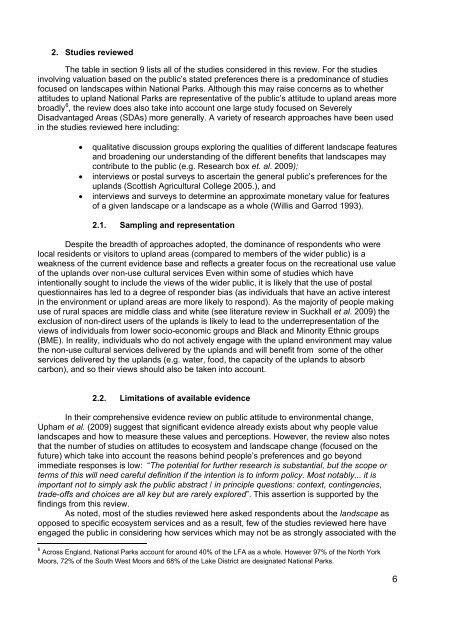Public Attitudes and Preferences for Upland Landscapes - Defra
Public Attitudes and Preferences for Upland Landscapes - Defra
Public Attitudes and Preferences for Upland Landscapes - Defra
You also want an ePaper? Increase the reach of your titles
YUMPU automatically turns print PDFs into web optimized ePapers that Google loves.
2. Studies reviewed<br />
The table in section 9 lists all of the studies considered in this review. For the studies<br />
involving valuation based on the public’s stated preferences there is a predominance of studies<br />
focused on l<strong>and</strong>scapes within National Parks. Although this may raise concerns as to whether<br />
attitudes to upl<strong>and</strong> National Parks are representative of the public’s attitude to upl<strong>and</strong> areas more<br />
broadly 6 , the review does also take into account one large study focused on Severely<br />
Disadvantaged Areas (SDAs) more generally. A variety of research approaches have been used<br />
in the studies reviewed here including:<br />
• qualitative discussion groups exploring the qualities of different l<strong>and</strong>scape features<br />
<strong>and</strong> broadening our underst<strong>and</strong>ing of the different benefits that l<strong>and</strong>scapes may<br />
contribute to the public (e.g. Research box et. al. 2009);<br />
• interviews or postal surveys to ascertain the general public’s preferences <strong>for</strong> the<br />
upl<strong>and</strong>s (Scottish Agricultural College 2005.), <strong>and</strong><br />
• interviews <strong>and</strong> surveys to determine an approximate monetary value <strong>for</strong> features<br />
of a given l<strong>and</strong>scape or a l<strong>and</strong>scape as a whole (Willis <strong>and</strong> Garrod 1993).<br />
2.1. Sampling <strong>and</strong> representation<br />
Despite the breadth of approaches adopted, the dominance of respondents who were<br />
local residents or visitors to upl<strong>and</strong> areas (compared to members of the wider public) is a<br />
weakness of the current evidence base <strong>and</strong> reflects a greater focus on the recreational use value<br />
of the upl<strong>and</strong>s over non-use cultural services Even within some of studies which have<br />
intentionally sought to include the views of the wider public, it is likely that the use of postal<br />
questionnaires has led to a degree of responder bias (as individuals that have an active interest<br />
in the environment or upl<strong>and</strong> areas are more likely to respond). As the majority of people making<br />
use of rural spaces are middle class <strong>and</strong> white (see literature review in Suckhall et al. 2009) the<br />
exclusion of non-direct users of the upl<strong>and</strong>s is likely to lead to the underrepresentation of the<br />
views of individuals from lower socio-economic groups <strong>and</strong> Black <strong>and</strong> Minority Ethnic groups<br />
(BME). In reality, individuals who do not actively engage with the upl<strong>and</strong> environment may value<br />
the non-use cultural services delivered by the upl<strong>and</strong>s <strong>and</strong> will benefit from some of the other<br />
services delivered by the upl<strong>and</strong>s (e.g. water, food, the capacity of the upl<strong>and</strong>s to absorb<br />
carbon), <strong>and</strong> so their views should also be taken into account.<br />
2.2. Limitations of available evidence<br />
In their comprehensive evidence review on public attitude to environmental change,<br />
Upham et al. (2009) suggest that significant evidence already exists about why people value<br />
l<strong>and</strong>scapes <strong>and</strong> how to measure these values <strong>and</strong> perceptions. However, the review also notes<br />
that the number of studies on attitudes to ecosystem <strong>and</strong> l<strong>and</strong>scape change (focused on the<br />
future) which take into account the reasons behind people’s preferences <strong>and</strong> go beyond<br />
immediate responses is low: “The potential <strong>for</strong> further research is substantial, but the scope or<br />
terms of this will need careful definition if the intention is to in<strong>for</strong>m policy. Most notably... it is<br />
important not to simply ask the public abstract / in principle questions: context, contingencies,<br />
trade-offs <strong>and</strong> choices are all key but are rarely explored”. This assertion is supported by the<br />
findings from this review.<br />
As noted, most of the studies reviewed here asked respondents about the l<strong>and</strong>scape as<br />
opposed to specific ecosystem services <strong>and</strong> as a result, few of the studies reviewed here have<br />
engaged the public in considering how services which may not be as strongly associated with the<br />
6 Across Engl<strong>and</strong>, National Parks account <strong>for</strong> around 40% of the LFA as a whole. However 97% of the North York<br />
Moors, 72% of the South West Moors <strong>and</strong> 68% of the Lake District are designated National Parks.<br />
6
















